The Mechanisms of Tetracycline in Shaping Antibiotic Resistance Gene Dynamics in Earthworm Casts During Vermicomposting
Abstract
1. Introduction
2. Materials and Methods
2.1. Cow Manure, Earthworms, and Reagents
2.2. Experiment Program
2.3. Sample Collection
2.4. Quantification of Antibiotic Resistance Genes and Mobile Genetic Elements
2.5. Microbial Community Analysis
2.6. Data Analysis
3. Results and Discussion
3.1. Distribution of and Variation in Antibiotic Resistance Genes in Vermicomposting
3.2. Fate of Antibiotic Resistance Genes in the Casts Under Tetracycline Stress
3.3. Changes in Mobile Genetic Elements in Casts Under Tetracycline Stress
3.4. Impact of Tetracycline on Bacterial Communities Within Earthworm Casts
3.5. Mechanisms of Tetracycline’s Influence on Antibiotic Resistance Genes During Earthworm Gut Digestion
4. Conclusions
Supplementary Materials
Author Contributions
Funding
Institutional Review Board Statement
Informed Consent Statement
Data Availability Statement
Acknowledgments
Conflicts of Interest
References
- Sadeghpour, A.; Afshar, R.K. Livestock manure: From waste to resource in a circular economy. J. Agric. Food Res. 2024, 17, 101255. [Google Scholar]
- Li, Y.; Shi, Y.; Deng, X.-Z.; Sun, Z.-G.; Accatino, F. Increasing food and feed self-sufficiency and avoiding manure N surplus in eastern regions of China through a spatial crop-livestock optimisation model. Agric. Sys. 2024, 217, 103911. [Google Scholar]
- Pedizzi, C.; Noya, I.; Sarli, J.; González-García, S.; Lema, J.M.; Moreira, M.T.; Carballa, M. Environmental assessment of alternative treatment schemes for energy and nutrient recovery from livestock manure. Waste Manag. 2018, 77, 276–286. [Google Scholar]
- Zhao, K.-Q.; Yin, X.-W.; Wang, N.-Y.; Chen, N.-Q.; Jiang, Y.-M.; Deng, L.-Y.; Xiao, W.-B.; Zhou, K.; He, Y.; Zhao, X.-C.; et al. Optimizing the management of aerobic composting for antibiotic resistance genes elimination: A review of future strategy for livestock manure resource utilization. J. Environ. Manag. 2024, 370, 122766. [Google Scholar] [CrossRef]
- Shen, C.; He, M.-Y.; Zhang, J.-H.; Liu, J.-L.; Wang, Y.-D. Response of soil antibiotic resistance genes and bacterial communities to fresh cattle manure and organic fertilizer application. J. Environ. Manag. 2024, 349, 119453. [Google Scholar]
- Wang, F.; Zhang, Y.-C.; Su, Y.-L.; Wu, D.; Xie, B. Pollutant control and nutrient recovery of organic solid waste by earthworms: Mechanism and agricultural benefits of vermicomposting. J. Environ. Chem. Eng. 2024, 12, 112610. [Google Scholar]
- Enebe, M.C.; Erasmus, M. Vermicomposting technology—A perspective on vermicompost production technologies, limitations and prospects. J. Environ. Manag. 2023, 345, 118585. [Google Scholar]
- Li, Z.-H.; Yang, F.-X.; Han, B.-J.; Zhao, R.; Yang, M.; Zhang, K.-Q. Vermicomposting significantly reduced antibiotic resistance genes in cow manure even under high tetracycline concentrations. Bioresour. Technol. 2025, 419, 132002. [Google Scholar]
- Huang, K.; Xia, H.; Zhang, Y.-Y.; Li, J.-H.; Cui, G.-Y.; Li, F.-S.; Bai, W.; Jiang, Y.-F.; Wu, N. Elimination of antibiotic resistance genes and human pathogenic bacteria by earthworms during vermicomposting of dewatered sludge by metagenomic analysis. Bioresour. Technol. 2020, 297, 122451. [Google Scholar]
- Domínguez, J.; Parmelee, R.W.; Edwards, C.A. Interactions between Eisenia andrei (Oligochaeta) and nematode populations during vermicomposting. Pedobiologia 2003, 47, 53–60. [Google Scholar]
- Xia, H.; Zhu, L.-C.; Ding, J.-G.; Chen, J.; Huang, K.; Zhao, M.; Li, F.-S.; Jiang, Y.-F. Earthworm gut digestion drives the transfer behavior of antibiotic resistance genes in layers of extracellular polymeric substances during vermicomposting of dewatered sludge. Environ. Res. 2024, 259, 119489. [Google Scholar] [PubMed]
- Chen, J.-B.; Xu, J.; Liu, T.-C.; Qian, Y.-J.; Zhou, X.-F.; Xiao, S.-Z.; Zhang, Y.-L. Selective oxidation of tetracyclines by peroxymonosulfate in livestock wastewater: Kinetics and non-radical mechanism. J. Hazard. Mater. 2020, 386, 121656. [Google Scholar]
- Xia, H.; Chen, J.-Y.; Chen, X.-M.; Huang, K.; Wu, Y. Effects of tetracycline residuals on humification, microbial profile and antibiotic resistance genes during vermicomposting of dewatered sludge. Environ. Pollut. 2019, 252, 1068–1077. [Google Scholar]
- Mu, M.-R.; Yang, F.-X.; Han, B.-J.; Ding, Y.-Z.; Zhang, K.-Q. Insights into the panorama of antibiotic resistome in cropland soils amended with vermicompost in China. Sci. Total Environ. 2023, 868, 161658. [Google Scholar] [PubMed]
- Wu, D.-N.; Dai, S.-T.; Feng, H.-D.; Parakrama Karunaratne, S.H.P.; Yang, M.; Zhang, Y. Persistence and potential risks of tetracyclines and their transformation products in two typical different animal manure composting treatments. Environ. Pollut. 2024, 341, 122904. [Google Scholar]
- Tian, X.-L.; Han, B.-J.; Liang, J.-F.; Yang, F.-X.; Zhang, K.-Q. Tracking antibiotic resistance genes (ARGs) during earthworm conversion of cow dung in northern China. Ecotoxicol. Environ. Saf. 2021, 222, 112538. [Google Scholar]
- Luo, F.; Zhao, Y.; Xu, J.-Y.; Wang, H.-T.; Zhu, D. Network complexity of bacterial community driving antibiotic resistome in the microbiome of earthworm guts under different land use patterns. J. Hazard. Mater. 2024, 461, 132732. [Google Scholar]
- Li, W.-J.; Li, J.-F.; Ahmad Bhat, S.; Wei, Y.-F.; Deng, Z.-Y.; Li, F.-S. Elimination of antibiotic resistance genes from excess activated sludge added for effective treatment of fruit and vegetable waste in a novel vermireactor. Bioresour. Technol. 2021, 325, 124695. [Google Scholar]
- Huang, K.; Xia, H.; Wu, Y.; Chen, J.-Y.; Cui, G.-Y.; Li, F.-S.; Chen, Y.-Z.; Wu, N. Effects of earthworms on the fate of tetracycline and fluoroquinolone resistance genes of sewage sludge during vermicomposting. Bioresour. Technol. 2018, 259, 32–39. [Google Scholar]
- Usui, M.; Fukuda, A.; Azuma, T.; Kobae, Y.; Hori, Y.; Kushima, M.; Katada, S.; Nakajima, C.; Suzuki, Y. Vermicomposting reduces the antimicrobial resistance in livestock waste. J. Hazard. Mater. Adv. 2024, 16, 100491. [Google Scholar]
- Zhang, M.-Q.; Yuan, L.; Li, Z.-H.; Zhao, H.-C.; Sheng, G.-P. Tetracycline exposure shifted microbial communities and enriched antibiotic resistance genes in the aerobic granular sludge. Environ. Int. 2019, 130, 104902. [Google Scholar]
- Zhou, C.-S.; Cao, G.-L.; Liu, B.-F.; Liu, W.; Ma, W.-L.; Ren, N.-Q. Deciphering the reduction of antibiotic resistance genes (ARGs) during medium-chain fatty acids production from waste activated sludge: Driven by inhibition of ARGs transmission and shift of microbial community. J. Hazard. Mater. 2024, 473, 134676. [Google Scholar] [PubMed]
- Chen, J.; Xia, H.; Huang, K.; Li, J.-H.; Xie, J.-C. Earthworms restructure the distribution of extracellular antibiotics resistance genes of sludge by modifying the structure of extracellular polymeric substances during vermicomposting. J. Hazard. Mater. 2023, 452, 131315. [Google Scholar] [PubMed]
- Liu, K.; Sun, M.-M.; Ye, M.; Chao, H.-Z.; Zhao, Y.-C.; Xia, B.; Jiao, W.-T.; Feng, Y.-F.; Zheng, X.-X.; Liu, M.-Q.; et al. Coexistence and association between heavy metals, tetracycline and corresponding resistance genes in vermicomposts originating from different substrates. Environ. Pollut. 2019, 244, 28–37. [Google Scholar] [PubMed]
- Guo, H.-G.; Li, Z.; Sun, X.-J.; Xing, M.-Y. Impact of earthworms on suppressing dissemination of antibiotic resistance genes during vermicomposting treatment of excess sludge. Bioresour. Technol. 2024, 406, 130991. [Google Scholar]
- Qian, X.; Sun, W.; Gu, J.; Wang, X.-J.; Sun, J.-J.; Yin, Y.-N.; Duan, M.-L. Variable effects of oxytetracycline on antibiotic resistance gene abundance and the bacterial community during aerobic composting of cow manure. J. Hazard. Mater. 2016, 315, 61–69. [Google Scholar]
- Zhang, Y.; Yuan, H.; Peng, S.-N.; Wang, Z.-Y.; Cai, S.-Y.; Chen, Z.-X.; Yang, B.-Y.; Yang, P.; Wang, D.-S.; Guo, J.-H.; et al. Vermicomposting preferably alters fungal communities in wasted activated sludge and promotes the production of plant growth-promoting biostimulants in the vermicompost. Chem. Eng. J. 2024, 495, 153232. [Google Scholar]
- Fu, X.-Y.; Huang, K.; Cui, G.-Y.; Chen, X.-M.; Li, F.-S.; Zhao, X.-Y.; Li, F. Dynamics of bacterial and eukaryotic community associated with stability during vermicomposting of pelletized dewatered sludge. Int. Biodeterior. Biodegrad. 2015, 104, 452–459. [Google Scholar]
- Wang, J.-J.; Lv, L.; An, X.-H.; Zhang, C.-R.; Tang, T.; Sun, Y.-Y.; Wang, F.-D. Combined effects of different-sized microplastics and fluindapyr on earthworm: Bioaccumulation, oxidative stress, histopathological responses and gut microbiota. Environ. Pollut. 2025, 366, 125478. [Google Scholar]
- Yang, F.-X.; Wang, X.-L.; Tian, X.-L.; Zhang, Z.-L.; Zhang, K.; Zhang, K.-Q. Cow manure simultaneously reshaped antibiotic and metal resistome in the earthworm gut tract by metagenomic analysis. Sci. Total Environ. 2023, 856, 159010. [Google Scholar]
- Xu, B.; Chu, T.-T.; Zhang, R.-R.; Yang, R.-Y.; Zhu, M.; Guo, F.-Y.; Zan, S.-T. Earthworm gut bacteria facilitate cadmium immobilization through the formation of CdS nanoparticles. Chemosphere 2024, 361, 142453. [Google Scholar] [PubMed]
- Lukashe, N.S.; Mupambwa, H.A.; Green, E.; Mnkeni, P.N.S. Inoculation of fly ash amended vermicompost with phosphate solubilizing bacteria (Pseudomonas fluorescens) and its influence on vermi-degradation, nutrient release and biological activity. Waste Manag. 2019, 83, 14–22. [Google Scholar] [PubMed]
- Yang, Y.-R.; Callaham, M.A.; Wu, X.-F.; Zhang, Y.-F.; Wu, D.-H.; Wang, D.-L. Gut microbial communities and their potential roles in cellulose digestion and thermal adaptation of earthworms. Sci. Total Environ. 2023, 903, 166666. [Google Scholar]
- Qin, X.; Huang, W.; Li, Q. Lignocellulose biodegradation to humic substances in cow manure-straw composting: Characterization of dissolved organic matter and microbial community succession. Int. J. Biol. Macromol. 2024, 283, 137758. [Google Scholar]
- Cao, Y.; Zhao, J.-H.; Wang, Q.-Q.; Bai, S.; Yang, Q.-X.; Wei, Y.-X.; Wang, R.-F. Industrial aerobic composting and the addition of microbial agents largely reduce the risks of heavy metal and ARG transfer through livestock manure. Ecotoxicol. Environ. Saf. 2022, 239, 113694. [Google Scholar] [PubMed]
- Zhu, B.-K.; Chen, Q.-L.; Chen, S.-C.; Zhu, Y.-G. Does organically produced lettuce harbor higher abundance of antibiotic resistance genes than conventionally produced? Environ. Int. 2017, 98, 152–159. [Google Scholar]
- Li, C.-F.; Zhang, Y.-R.; Tan, Z.-C.; Xu, H.-J.; Liu, C.-L. Enantioselective effect of the chiral fungicide tebuconazole on the microbiota community and antibiotic resistance genes in the soil and earthworm gut. Sci. Total Environ. 2023, 897, 165381. [Google Scholar]
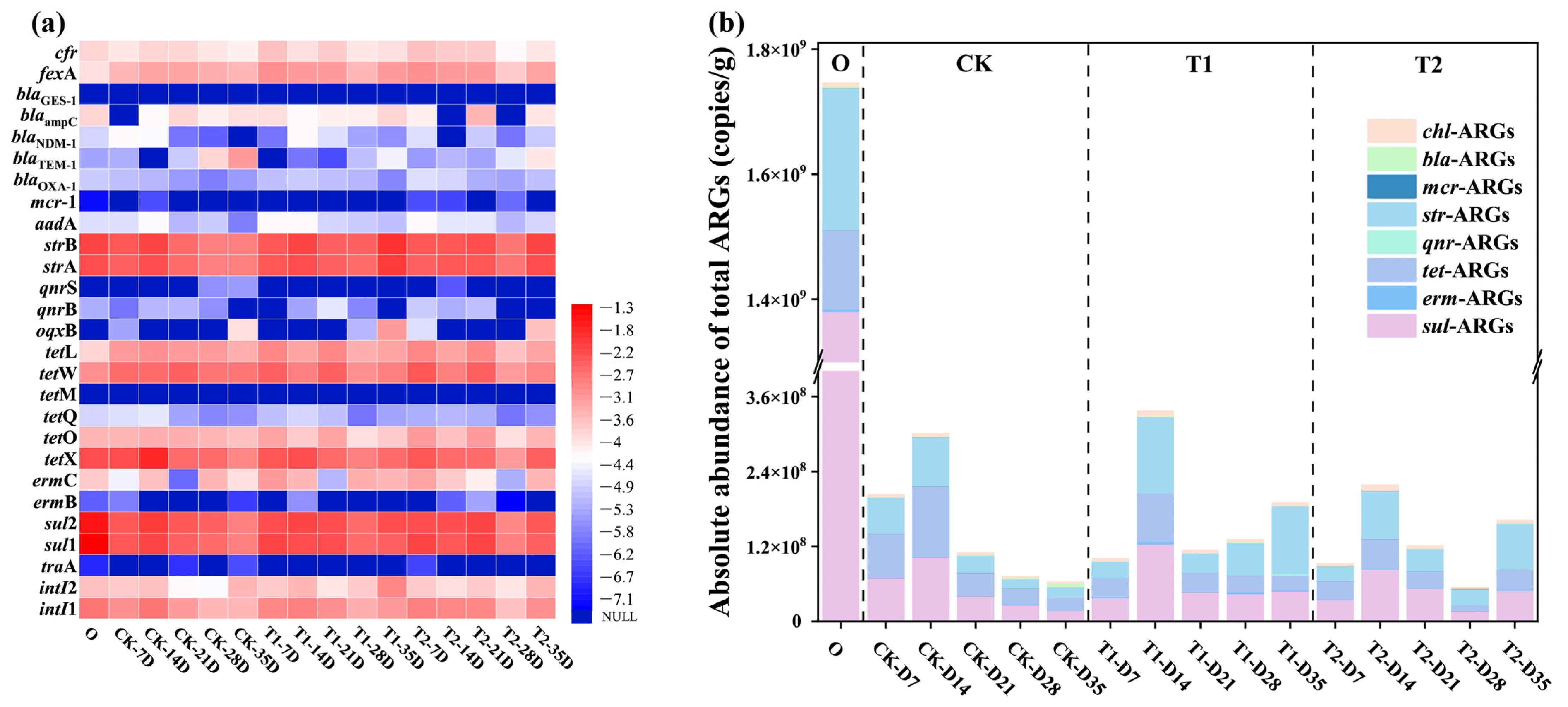
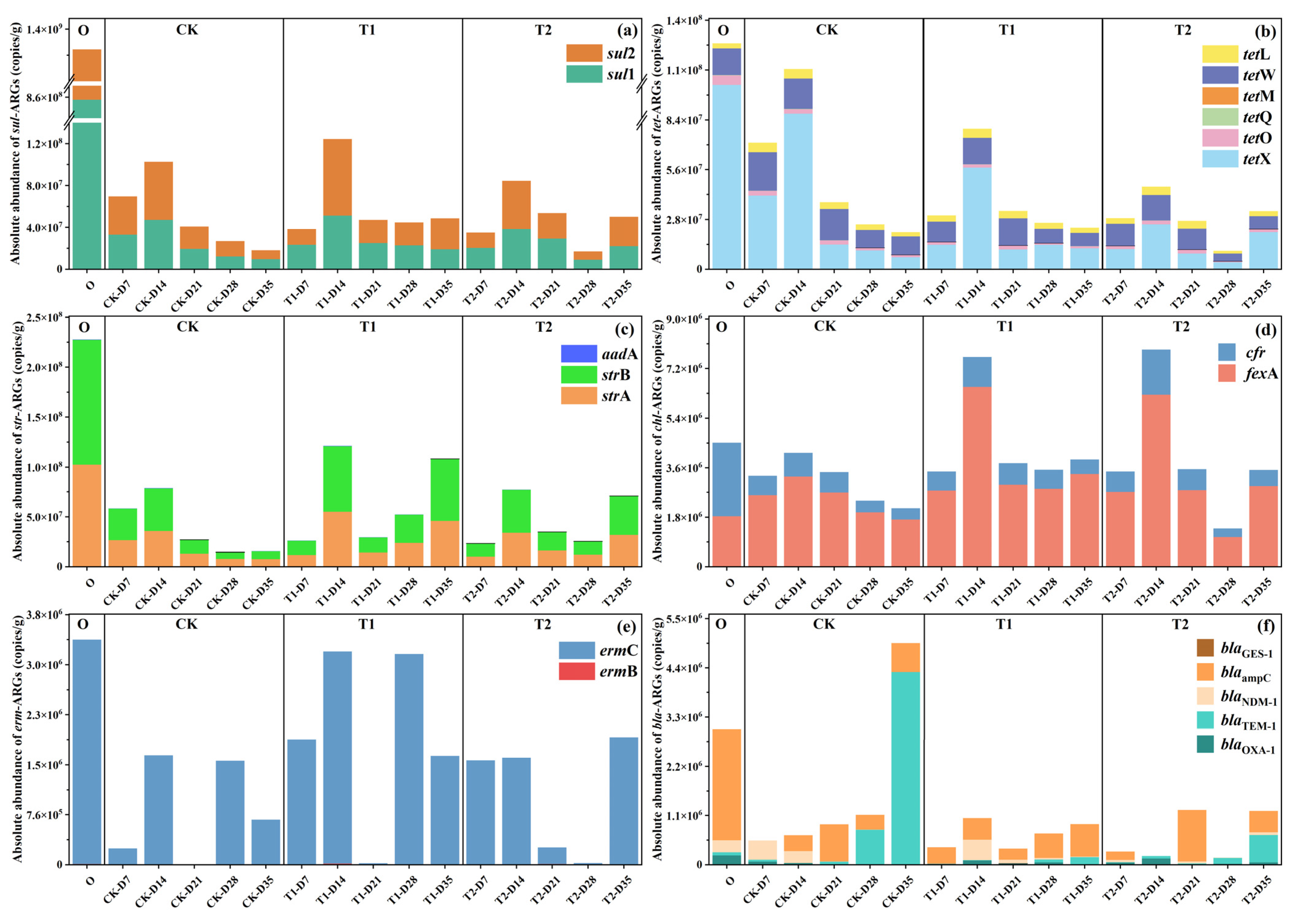
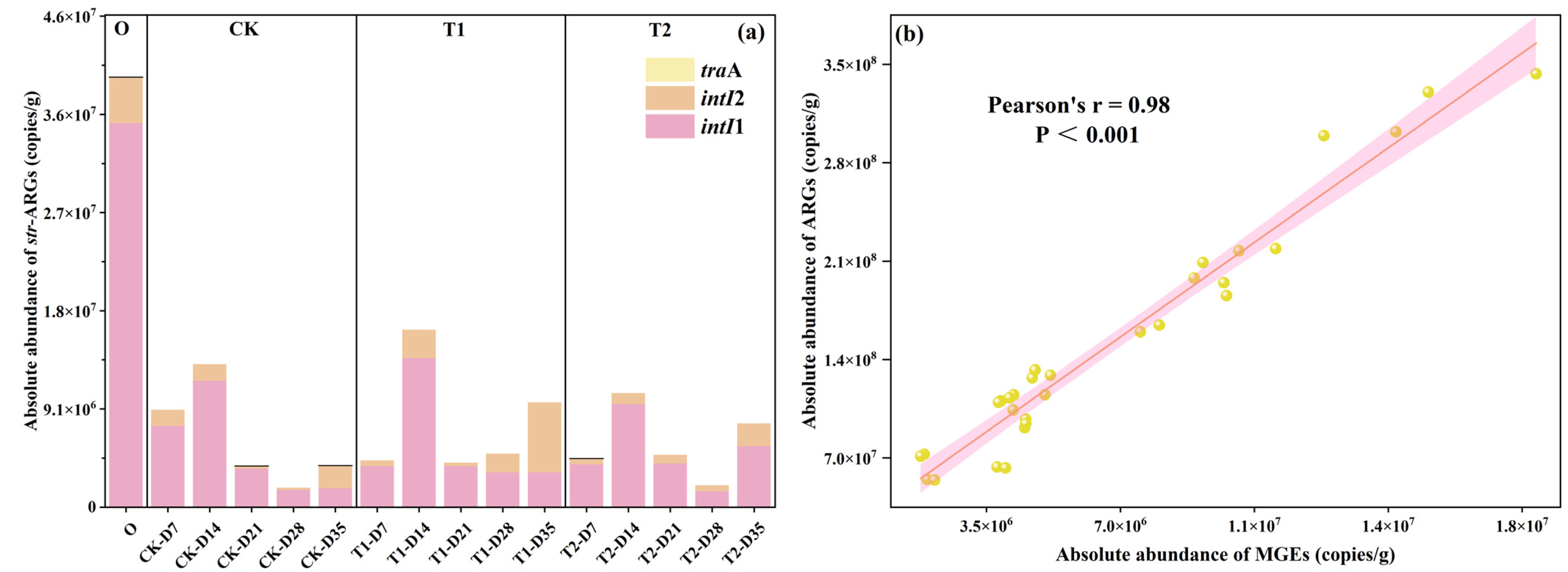
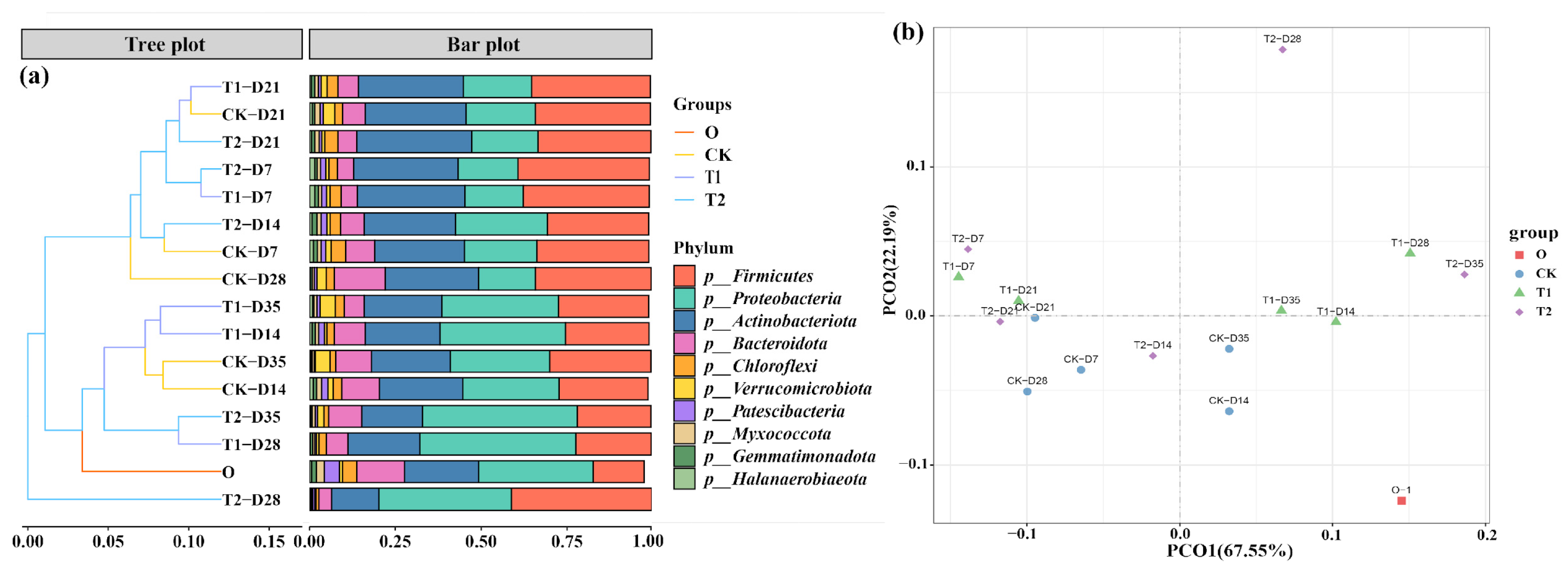
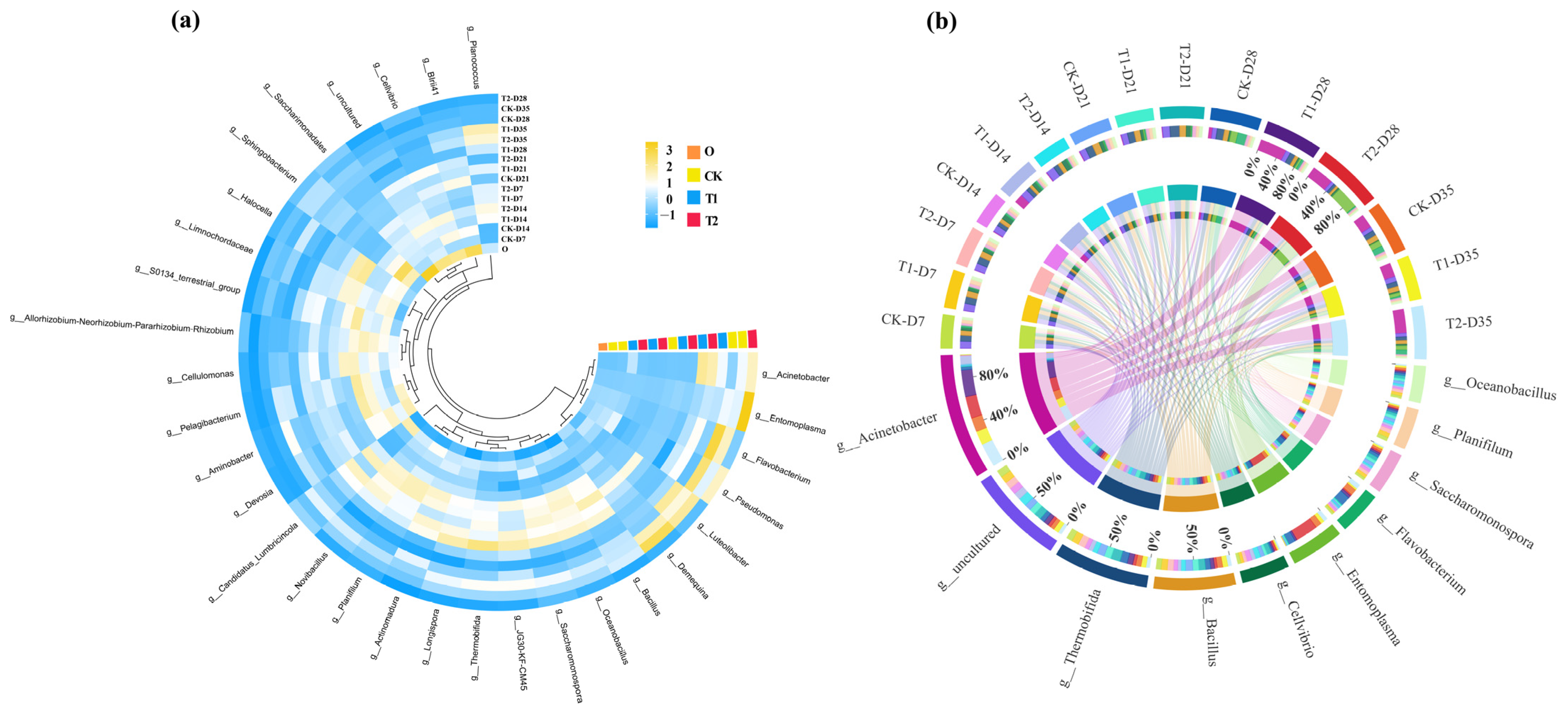
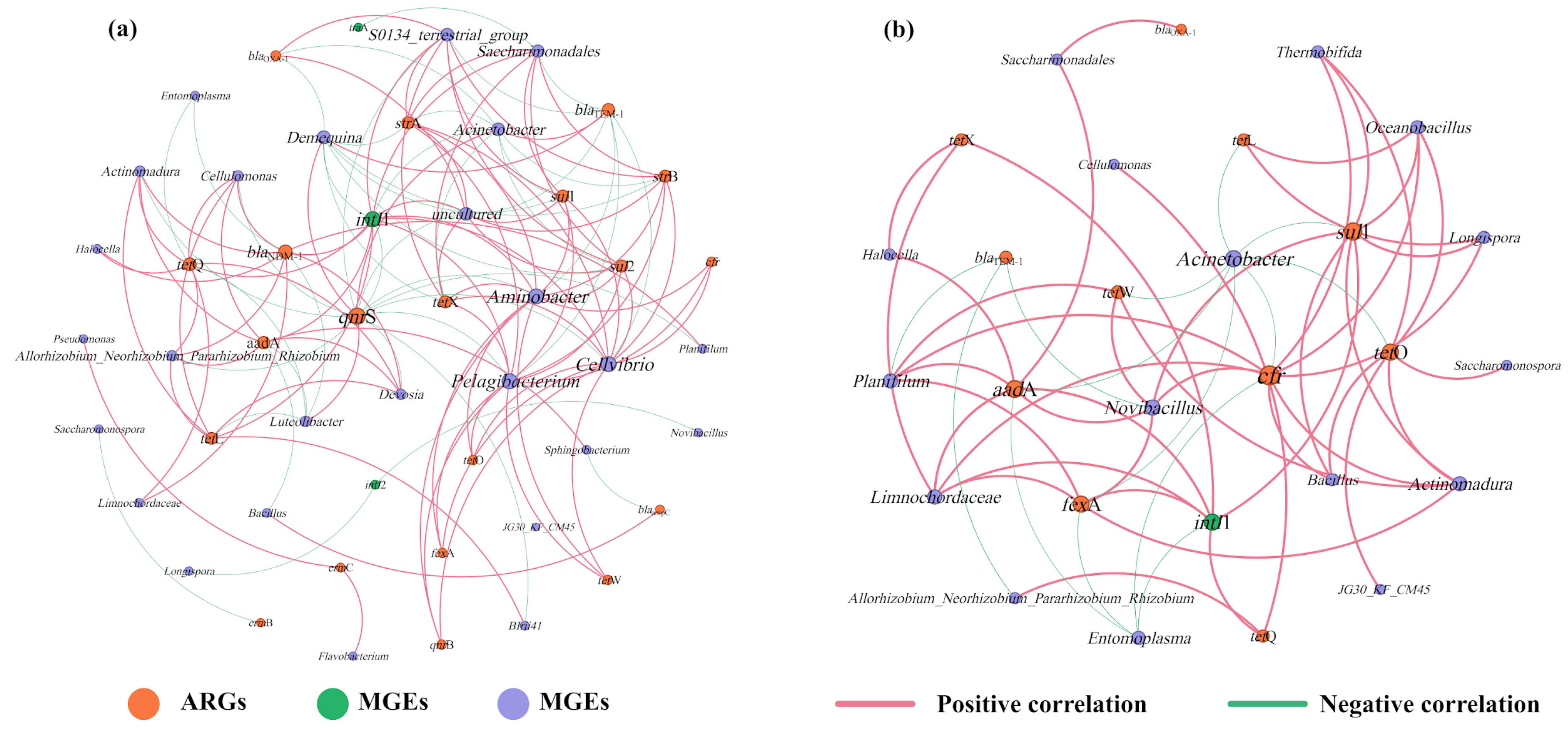
| Index | Cow Manure |
|---|---|
| Water content (%) | 75.75 ± 1.31 |
| pH | 8.52 ± 0.10 |
| Total nitrogen (%) | 1.64 ± 0.30 |
| Total phosphorus (%) | 1.42 ± 0.20 |
| Total potassium (%) | 1.70 ± 0.30 |
| Nitrate nitrogen (mg/kg) | 107.12 ± 5.80 |
| Ammonium nitrogen (mg/kg) | 261.92 ± 18.76 |
| Organic matter (%) | 52.25 ± 1.62 |
Disclaimer/Publisher’s Note: The statements, opinions and data contained in all publications are solely those of the individual author(s) and contributor(s) and not of MDPI and/or the editor(s). MDPI and/or the editor(s) disclaim responsibility for any injury to people or property resulting from any ideas, methods, instructions or products referred to in the content. |
© 2025 by the authors. Licensee MDPI, Basel, Switzerland. This article is an open access article distributed under the terms and conditions of the Creative Commons Attribution (CC BY) license (https://creativecommons.org/licenses/by/4.0/).
Share and Cite
Li, Z.; Yang, F.; Yang, M.; Yan, R.; Zhang, K. The Mechanisms of Tetracycline in Shaping Antibiotic Resistance Gene Dynamics in Earthworm Casts During Vermicomposting. Toxics 2025, 13, 273. https://doi.org/10.3390/toxics13040273
Li Z, Yang F, Yang M, Yan R, Zhang K. The Mechanisms of Tetracycline in Shaping Antibiotic Resistance Gene Dynamics in Earthworm Casts During Vermicomposting. Toxics. 2025; 13(4):273. https://doi.org/10.3390/toxics13040273
Chicago/Turabian StyleLi, Zhonghan, Fengxia Yang, Ming Yang, Renkai Yan, and Keqiang Zhang. 2025. "The Mechanisms of Tetracycline in Shaping Antibiotic Resistance Gene Dynamics in Earthworm Casts During Vermicomposting" Toxics 13, no. 4: 273. https://doi.org/10.3390/toxics13040273
APA StyleLi, Z., Yang, F., Yang, M., Yan, R., & Zhang, K. (2025). The Mechanisms of Tetracycline in Shaping Antibiotic Resistance Gene Dynamics in Earthworm Casts During Vermicomposting. Toxics, 13(4), 273. https://doi.org/10.3390/toxics13040273







